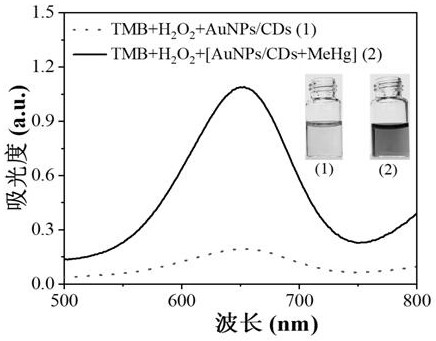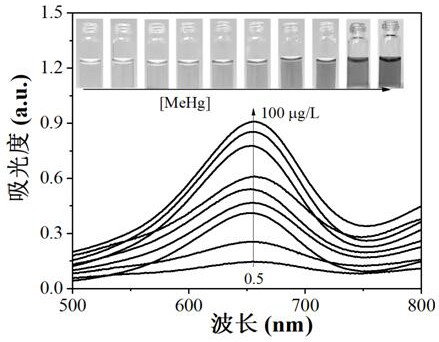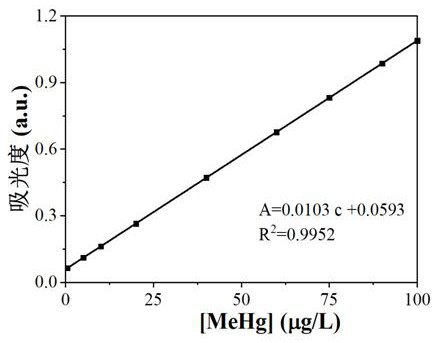Method for detecting methyl mercury based on gold nano-enzyme peroxidase
A technology of nano-enzyme peroxidase and methylmercury, which is applied in the direction of nano-carbon, nano-technology, nano-optics, etc., can solve the problems of unstable method, poor reproducibility, and easy aggregation, so as to avoid uneven color and carry Convenience, Analytical Sensitive Effects
- Summary
- Abstract
- Description
- Claims
- Application Information
AI Technical Summary
Problems solved by technology
Method used
Image
Examples
Embodiment 1
[0030] Example 1: Rapid detection of methylmercury in fish by carbon dot gold nanozyme
[0031] (1) Weigh 2.0g of serotonin and 1.0g of glucose and dissolve them in 20mL of ultrapure water, ultrasonically mix evenly, transfer the solution to a polytetrafluoroethylene-lined hydrothermal reactor, and heat it at a constant temperature of 200 °C for 6 hours to react. After completion, it was naturally cooled to room temperature to obtain a brown solution; the brown solution was removed with a 0.22 μm filter membrane to remove large particles of impurities, and then centrifuged at 8000 r / min, and the supernatant was dried in vacuum at 60 °C to obtain serotonin carbon dots;
[0032] (2) Dissolve 12 mg of serotonin carbon dots in 40 mL of ultrapure water, heat the oil bath to 100°C, and add HAuCl 4 , HAuCl 4 The concentration in the mixed solution was 10 mg / mL, stirred for 60 minutes in the dark, cooled to room temperature, centrifuged at 8000 r / min, and the supernatant was dried to...
Embodiment 2
[0048] Example 2: Rapid detection of methylmercury in environmental water samples by carbon dot gold nanozyme
[0049] (1) Weigh 3.0g of serotonin and 2.0g of glucose and dissolve them in 30mL of ultrapure water, ultrasonically mix evenly, transfer the solution to a polytetrafluoroethylene-lined hydrothermal reactor, and heat it at a constant temperature of 200 °C for 6 hours to react. After completion, it was naturally cooled to room temperature to obtain a brown solution; the brown solution was used to remove large particles of impurities with a 0.22 μm filter membrane, and then centrifuged at 8000 r / min, and the supernatant was vacuum-dried at 60 °C to obtain serotonin carbon dots;
[0050] (2) Dissolve 15 mg of serotonin carbon dots in 50 mL of ultrapure water, heat the oil bath to 100 °C, and add HAuCl 4 , HAuCl 4 The concentration in the mixed solution was 12 mg / mL, and the mixture was stirred for 60 minutes in the dark, cooled to room temperature, centrifuged at 8000 r...
PUM
 Login to View More
Login to View More Abstract
Description
Claims
Application Information
 Login to View More
Login to View More - R&D
- Intellectual Property
- Life Sciences
- Materials
- Tech Scout
- Unparalleled Data Quality
- Higher Quality Content
- 60% Fewer Hallucinations
Browse by: Latest US Patents, China's latest patents, Technical Efficacy Thesaurus, Application Domain, Technology Topic, Popular Technical Reports.
© 2025 PatSnap. All rights reserved.Legal|Privacy policy|Modern Slavery Act Transparency Statement|Sitemap|About US| Contact US: help@patsnap.com



